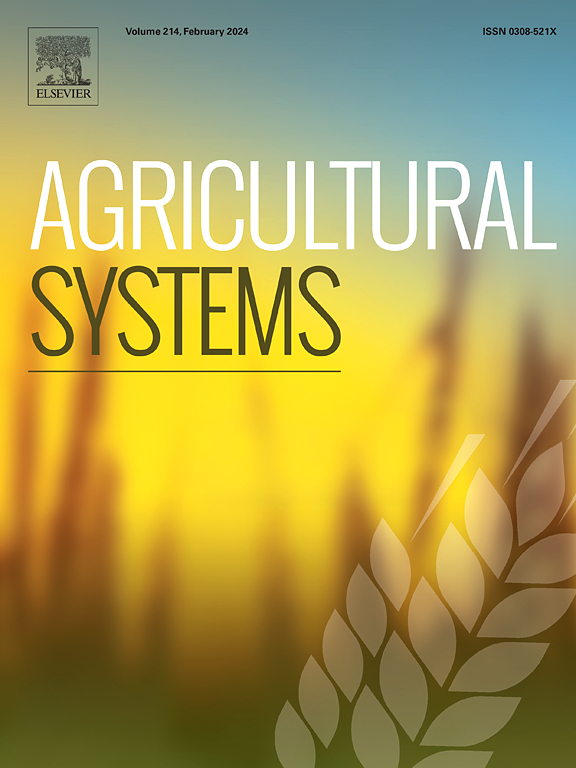越南北部的家庭蔬菜农业生物多样性需要种子来源的多样性
IF 6.1
1区 农林科学
Q1 AGRICULTURE, MULTIDISCIPLINARY
引用次数: 0
摘要
尽管人们对农业生物多样性的兴趣日益浓厚,但关于种子来源多样性和相关种子系统在支持蔬菜多样性中的作用的研究很少。目的分析蔬菜多样性和农民种子来源选择的驱动因素。此外,我们还探讨了蔬菜多样性与种子资源利用之间的关系。我们把重点放在越南北部社区的家庭上,那里有大量的蔬菜多样性。方法采用51次利益相关者访谈、13次焦点小组讨论和问卷调查的方式,对2个地区32个村庄的409户家庭进行调查。蔬菜多样性被定义为独特蔬菜的数量。贝叶斯混合效应模型用于分析影响蔬菜多样性和农民种子采购决策的因素。结果与结论平均每户种植8种蔬菜(范围1-27),使用2种种子来源(范围1-6)。耕地面积减少导致多样性减少。种植更多的蔬菜与女性在蔬菜生产方面有更多年的经验和使用更多的种子来源有关。自保种子很常见,但家庭依赖于难以生产和/或保存的农场外种子来源。中间商创造了中间的种子系统,从而将农民与正式的种子系统联系起来。随着蔬菜多样性较大的家庭使用更多的种子来源,综合种子部门的发展应加强所有现有种子来源的可靠性,以保持蔬菜多样性。这包括中介和信息的可靠性,以及提高农民在生产和保存自己的种子方面的能力和作用。本文章由计算机程序翻译,如有差异,请以英文原文为准。

Household vegetable agro-biodiversity in northern Vietnam requires diversity in seed sources
CONTEXT
Despite increasing interest in agro-biodiversity, there is little research on the role of diversity in seed sources and related seed systems in supporting vegetable diversity.
OBJECTIVE
We aimed to analyze drivers of vegetable diversity and of farmers' choice of seed sources. Moreover, we explored how vegetable diversity and the use of seed sources were related. We focused on households of communities in northern Vietnam with large vegetable diversity as a case in point.
METHODS
We conducted 51 stakeholder interviews, 13 focus group discussions, and a survey among 409 households in 32 villages in 2 contrasting regions. Vegetable diversity was defined as counts of unique vegetables. Bayesian mixed-effect models were used to elucidate which factors influenced vegetable diversity at household level, and farmers' seed sourcing decisions.
RESULTS AND CONCLUSIONS
On average, households grew 8 (range 1–27) vegetables and used 2 (range 1–6) seed sources. Smaller crop land area resulted in less diversity. Growing more vegetables was associated with women having more years of experience in vegetable production and using more seed sources. Self-saved seed was common, but households relied on off-farm sources for seed that was difficult to produce and/or preserve. Intermediaries created intermediate seed systems, thus linking farmers to formal seed systems.
SIGNIFICANCE
As households with larger vegetable diversity used more seed sources, integrated seed sector development should strengthen reliability of all current seed sources to maintain vegetable diversity. This includes reliability of intermediaries and information, and enhancing farmers' capacity for and role in producing and preserving their own seed.
求助全文
通过发布文献求助,成功后即可免费获取论文全文。
去求助
来源期刊

Agricultural Systems
农林科学-农业综合
CiteScore
13.30
自引率
7.60%
发文量
174
审稿时长
30 days
期刊介绍:
Agricultural Systems is an international journal that deals with interactions - among the components of agricultural systems, among hierarchical levels of agricultural systems, between agricultural and other land use systems, and between agricultural systems and their natural, social and economic environments.
The scope includes the development and application of systems analysis methodologies in the following areas:
Systems approaches in the sustainable intensification of agriculture; pathways for sustainable intensification; crop-livestock integration; farm-level resource allocation; quantification of benefits and trade-offs at farm to landscape levels; integrative, participatory and dynamic modelling approaches for qualitative and quantitative assessments of agricultural systems and decision making;
The interactions between agricultural and non-agricultural landscapes; the multiple services of agricultural systems; food security and the environment;
Global change and adaptation science; transformational adaptations as driven by changes in climate, policy, values and attitudes influencing the design of farming systems;
Development and application of farming systems design tools and methods for impact, scenario and case study analysis; managing the complexities of dynamic agricultural systems; innovation systems and multi stakeholder arrangements that support or promote change and (or) inform policy decisions.
 求助内容:
求助内容: 应助结果提醒方式:
应助结果提醒方式:


